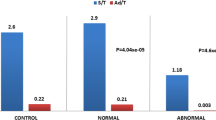Abstract
Retractile testes are frequently observed. There is currently disagreement concerning the definition of retractile testes, and therefore their treatment is still controversial. The microscopic description of testicular biopsies is usually focused on germ cells. This study describes Sertoli-cell morphology in retractile testes. Ten biopsies of retractile testes from 9 children aged 4–10 years and 1 biopsy of a descended testis from a child 2 months of age were examined by light and electron microscopy. Based on Sertoli-cell morphology, tubular degeneration phases V–VII according to the classification of Rune were observed in 80% of retractile-testis biopsies, but not in the biopsy of the descended testis. Electron microscopy revealed dilatations of rough endoplasmic reticulum, irregular outlines of nuclear membranes, and vacuolization of cytoplasm in Sertoli cells of retractile testes. We conclude that Sertoli cells of retractile testes. We conclude that Sertoli cells in retractile testes, according to the definition of Goh and Hutson, do show distinct morphologic alterations resembling those alterations observed in cryptorchid testes.
Similar content being viewed by others
References
Goh DW, Hutson JM (1992) Is the retractile testis a normal, physiological variant or an anomaly that requires active treatment? Pediatr Surg Int 7: 249–252
Hadziselimovic F (1983) Histology and ultrastructure of normal and cryptorchid testes. In: Hadziselimovic F (ed) Cryptorchidism. Management and implications. Springer-Verlag Berlin Heidelberg New York, pp 35–58
Hadziselimovic F (1983) Examination and clinical findings in cryptorchid boys. In: Hadziselimovic F (ed) Cryptorchidism. Management and implications. Springer-Verlag Berlin Heidelberg New York, pp 93–98
Hadziselimovic F, Herzog B (1990) Hodenerkrankungen im Kindesalter. Hippokrates, Sttutgart, pp 33–45
Hansson V (1978) Discussion. In: Senge T, Neumann F, Schenck B (eds) Physiologie and Pathophysiologie der Hodenfunktion. Thieme, Stuttgart New York, p 168
Hezmal HP, Lipshultz LI (1982) Cryptorchidism and infertility. Urol Clin North Am 93: 361
Läckgren G, Plöen L (1984) The influence of human chorionic gonadotrophin (hcG) on the morphology of the prepubertal human undescended testis. Int J Androl 7: 39–52
Mayr J, Becker H, Neugebauer H, Sauer H (1990) Ergebnisse von Hodenbiopsien bei 106 Pendelhoden. In: Schier F, Waldschmidt J (eds) Maldescensus testis. Zuckschwerdt, München Bern Wien San Francisco, pp 104–105
Nistal M, Paniagua R (1984) Testicular and epididymal pathology. Thieme-Stratton, New York 10: 140–144
Puri P, Nixon HH (1977) Bilateral retractile testes — subsequent effects on fertility. J Pediatr Surg 12: 563–567
Reynolds SE (1963) The use of lead citrate as an electron opaque stain in electron microscopy. J Cell Biol 17: 208–212
Richardson UE, Jarret L, Finke EH (1960) Embedding in epoxy resins for ultrathin sectioning in electron microscopy. Stain Technol 35: 313–323
Rune GM, Mayr J, Neugebauer H, Anders CH, Sauer H (1992) Pattern of Sertoli cell degeneration in cryptorchid prepubertal testes. Int J Androl 15: 19–31
Scorer CG, Farrington GH (1971) Boyhood and adolescence: retraction of the testis and epididymis. In: Scorer CG, Farrington GH (eds) Congenital deformities of the testis and epididymis. Butterworth, London, pp 45–75
Städler F, Hartmann R (1972) Histologische und morphometrische Untersuchungen zum präpubertalen Hodenwachstum bei normalen und zerebral geschädigten Knaben. Dtsch Med Wochenschr 97: 104
Wyllie GG (1984) The retractile testis. Med J Aust 140: 403–405
Zachmann M, Prader A, Kind HP, Haefliger H, Buldinger H (1974) Testicular volume during adolescence. Cross-sectional and longitudinal studies. Helv Paediatr Acta 29: 61–72
Author information
Authors and Affiliations
Rights and permissions
About this article
Cite this article
Mayr, J., Rune, G.M., Fasching, G. et al. Sertoli cell morphology in retractile prepubertal testes. Pediatr Surg Int 9, 90–94 (1994). https://doi.org/10.1007/BF00176120
Accepted:
Issue Date:
DOI: https://doi.org/10.1007/BF00176120




